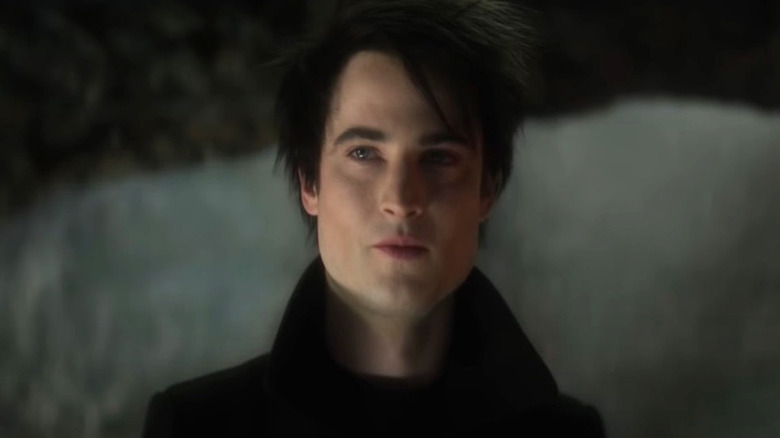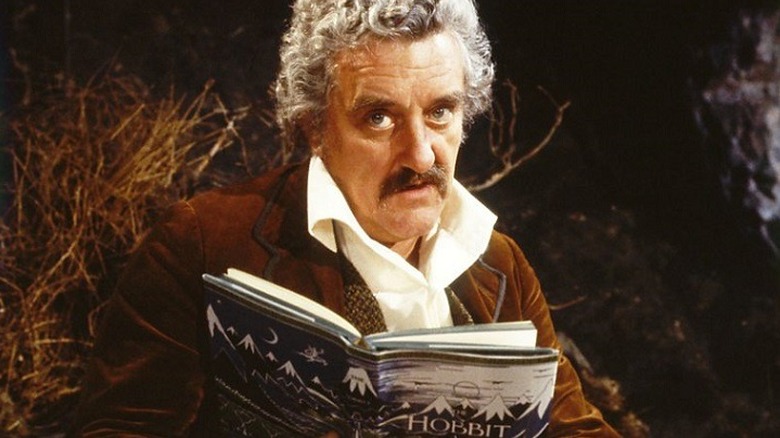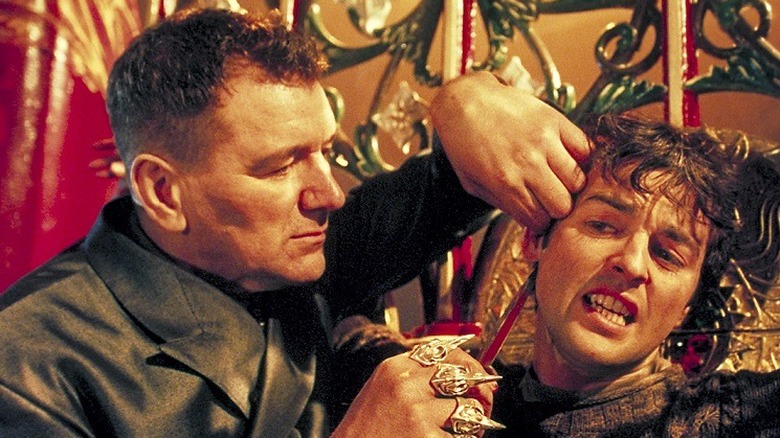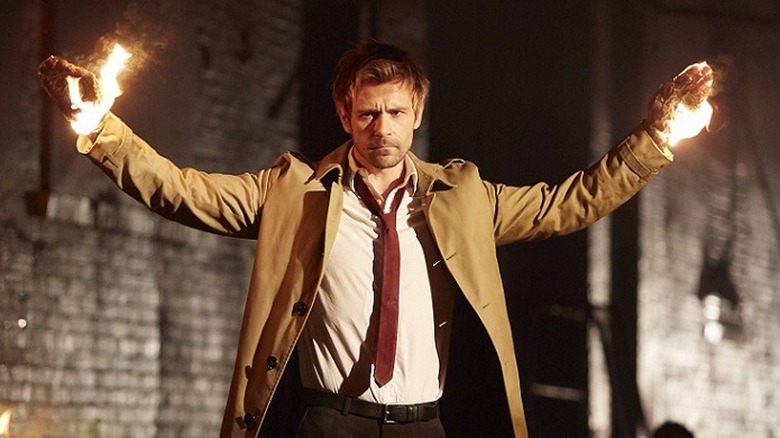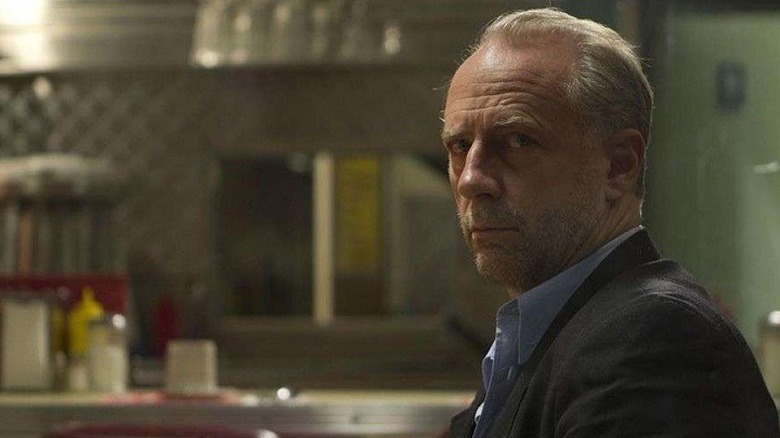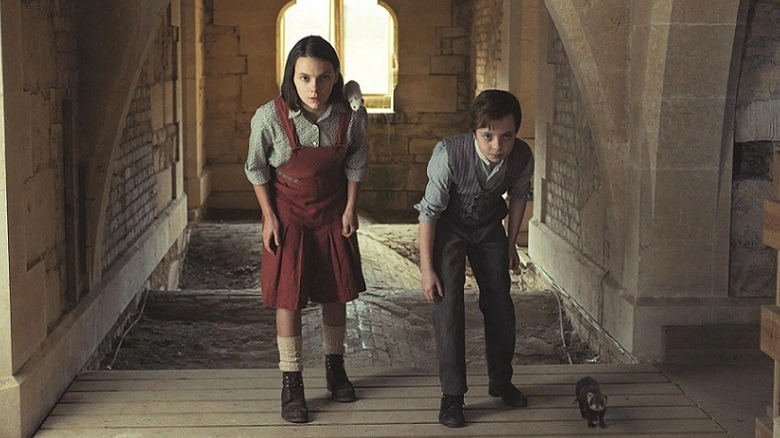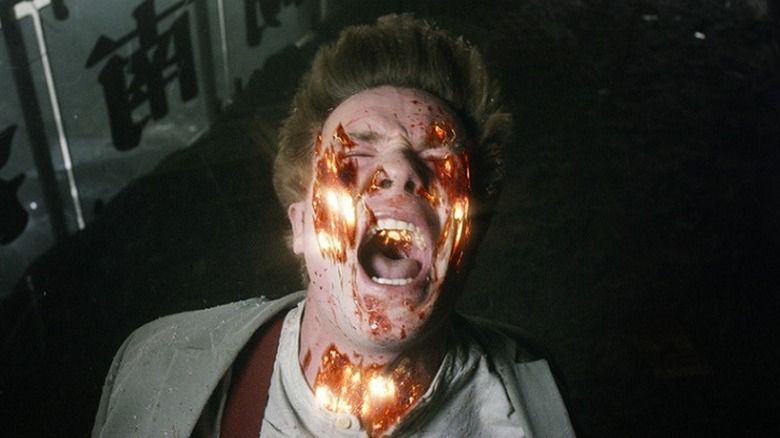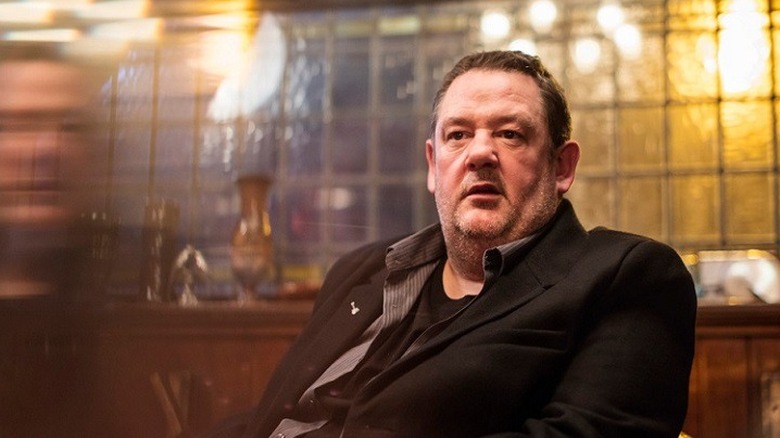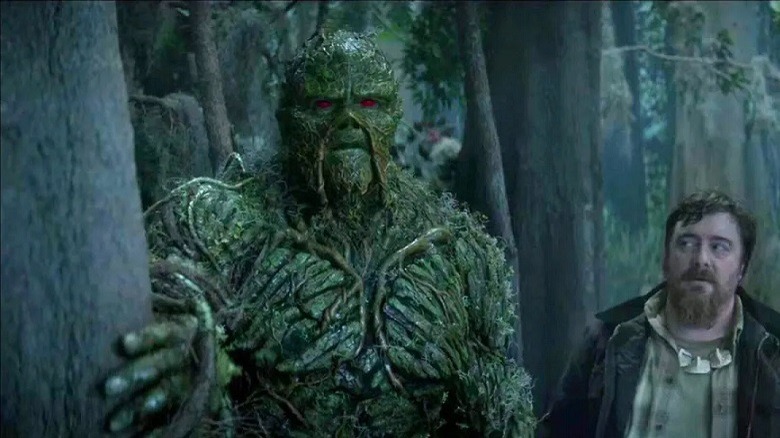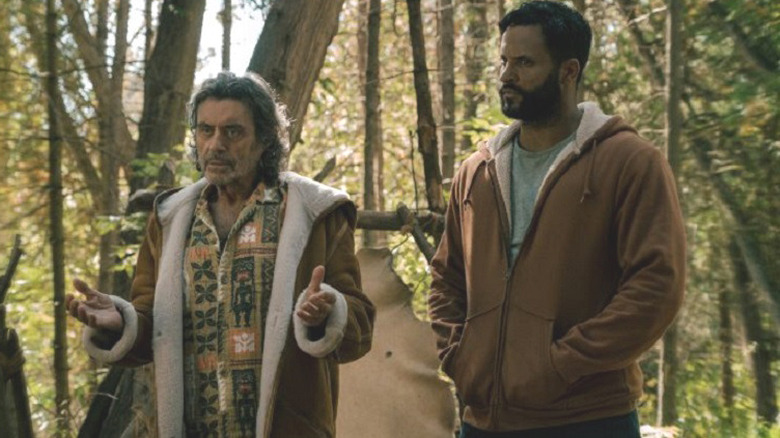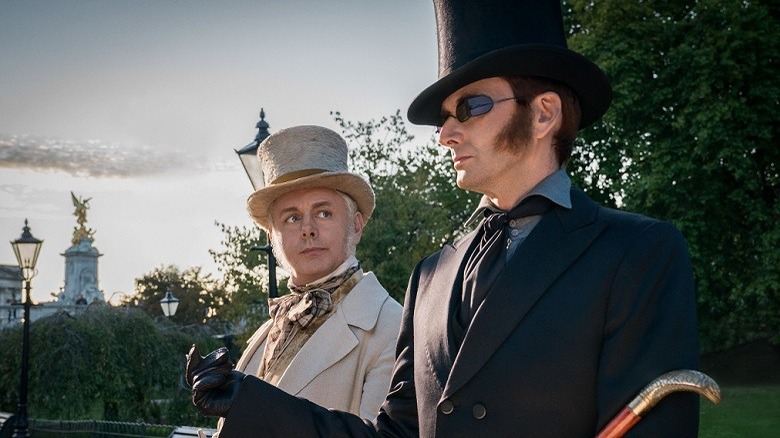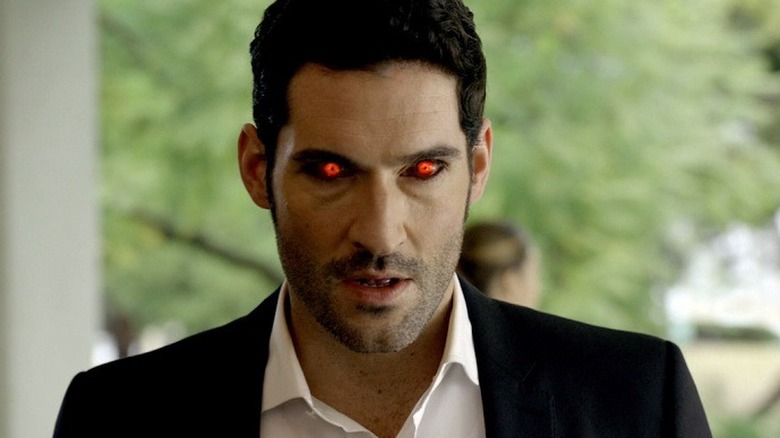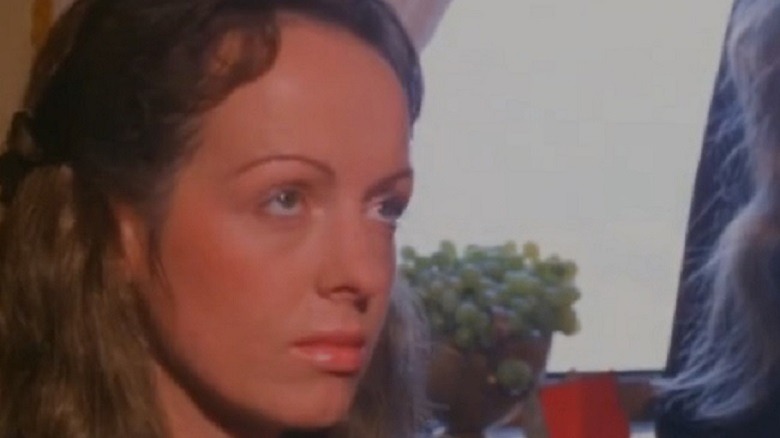The Sandman Fans Will Want To Watch These 12 Shows Next
With the concept of a "The Sandman" movie or television series languishing in the crowded confines of development hell for the best part of three decades, it was probably beyond even the imagination of Morpheus, the Lord of Dreams himself, to dare to imagine it would ever see fruition. Luckily, the nature of television has changed dramatically in the years since 1991. Comics have been adapted to the big and small screen with overwhelming success, so it should only have been expected that one of the biggest comic titles of all time would end up joining them.
Episodic television has allowed creatives the luxury of telling a story at their own pace, and a genre-savvy audience will be way more welcoming now to some of the concepts in "The Sandman" than they would have back then. With elements of fable and fairytale, kitchen-sink drama as well as horror, "The Sandman" spans themes like a colossus, so it's hard to pin down its precise appeal. However, here are 12 television shows that tread a familiar path or, in some cases, have a direct link in some way to "The Sandman." Some are easy to locate on physical media or streaming services, whereas others will prove more difficult to find than an Oneiromancer's sand pouch. Nonetheless, they're all worthy of your valuable time.
Jackanory (1965-1996)
One of the prevailing themes of "The Sandman" is the sheer power of storytelling, of the magic and strength of mythology and fables. Much of the narrative is concerned with the telling of tales, and few shows are as talismanic to the power of narrative as BBC's "Jackanory." The essence of the classic show, whose title was derived from a two-and-a-half-century-old nursery rhyme, was simplicity itself. A narrator, typically a well-known actor, would read aloud from a children's book. Often these were traditionally fables or fairy tales, but occasionally — and more towards the later years of the show — would feature more contemporary works. The narrators were a veritable Who's Who of English theatrical and television talent.
It would be the introduction to fiction for several generations' worth of children, and the long-running show (1965-1996) was such a cultural phenomenon and must-see program, that it's very unlikely that the young Neil Gaiman himself wouldn't have been exposed to it at an early age. Despite the show ending before the dawn of the millennium, the tradition has continued with the CBeebies Bedtime Stories, featuring such narrator talents as David Hasselhoff, Chris Hemsworth, Tom Hardy, and Dolly Parton. Many of the older (and more classic) episodes of "Jackanory" can be found recorded for posterity on YouTube, providing a rich storytelling resource.
Neverwhere (1996)
At the same time as the first full run of the comic of "The Sandman" was ending with issue 75 in 1996, "Neverwhere" was being broadcast for the first time on the BBC. A collaboration between Neil Gaiman and popular British comedian Lenny Henry, "Neverwhere" tells the tale of hapless city dweller Richard Mayhew and his excursions into a London below the one he knew existed. It's a mythical take on the plight of the invisibility of the homeless, positing the idea of what if those who were said to have fallen between the cracks of the society genuinely had, inhabiting a world little known to the people above?
Like the BBC's adaptation of "The Hitchhiker's Guide to the Galaxy" from 15 years previous, it's an overly ambitious tale done little justice by a meager television budget. Propelled along by the fast-paced story and an enthusiastic cast, though, it's a perfectly watchable and entertaining curio. And, perhaps most importantly, it remains an intriguing exploration of themes common to Gaiman's work, including the use of legendary characters from other stories. A case in point is one of Mayhew's traveling companions in his dangerous explorations of "London Below." The Marquis de Carabas is a charismatic and resourceful nobleman, but one whose name will be instantly recognizable to those familiar with the traditional fairy-tale "Puss in Boots."
Constantine (2014)
Neil Gaiman's worlds sing of a hidden, albeit far too real, magic, and John Constantine may be one of its most infamous practitioners. The blond-haired chain-smoking ex-punk conjurer might be sadly absent from "The Sandman" series — that honor goes to his relative, Johanna Constantine — but his DNA and magical essence are embedded in every aspect of the source material. In an event that came to be known as the British Invasion of comics, the two big American publishers (Marvel and DC) introduced a wealth of British scripting and artistic talent, amongst them the writers Neil Gaiman, Alan Moore, and Jamie Delano.
Their superlative works, "Sandman," "Swamp Thing," and "Hellblazer," respectively, clearly shared a universe, with characters from the comics occasionally crossing over into these sister titles. Indeed, it was later established that John was present at Dream's imprisonment at the hands of Roderick Burgess, and it was he who had possession of Dream's magical bag of sand. The sadly short-lived NBC series followed the exploits of the globe-hopping occultist, with tales loosely based on Jamie Delano's initial run on the title. The character would later appear (to lesser effect) in "Legends of Tomorrow," but by portraying the anti-hero in a far lesser light than his own entertaining show. John always came across as more of a light-hearted comedy sidekick in The CW series than the tortured loner that the comic series had carefully nurtured and developed.
The Booth at the End (2011-2012)
How far would you go to get what you want? That's the question posed in both seasons of this dark thriller, as we witness a group of disparate strangers faced with that precise conundrum. Wishes are a recurring theme in fables, and "The Sandman" reminds us that you'd often be wise to be careful what you wish for, in lessons learned by Roderick Burgess, Hob Gadling, and many other characters intertwined in the saga of Dream of the Endless.
In "The Booth at the End," we're introduced to a character simply known as The Man, a charismatic occupant of the titular booth in a stereotypical American diner. This central antagonist claims to be able to carry out any wish the requester desires, but only as a reward for performing a task for him. These tasks range from the seemingly simple and commonplace, to the inhumane and abhorrent. Fans of "The Sandman" will be all too aware of the horrors that even the seemingly mundane setting of a simple diner can convey, yet there are worse things to inhabit them than Dr. Dee. The true nature of The Man in the booth is never revealed, but from the Faustian nature of the various overlapping pacts that occur during each season, it doesn't make for a particularly tough guess. It's smart, profound, and well worth seeking out.
His Dark Materials (2019-2022)
If it's smart wise-cracking animal sidekicks you're fond of, (and "The Sandman" has them in spades, from Dream's Raven Matthew to Destruction's dog Barnabas), you'll appreciate the dæmons in "His Dark Materials." Essentially animal familiars, they're bonded to their human companions, with separation meaning likely death for both. Based on the popular fantasy trilogy by renowned author Philip Pullman, "The Golden Compass" movie was released in 2007. Failing to make a splash at the box office, the potential of any sequels dwindled rapidly. The BBC and HBO collaborated successfully to make the "His Dark Materials" series in 2019, promising to adapt each book of the trilogy into a separate season.
A cynical attitude towards the church — and biblical references that drew flak from several religious groups — saw the source material often banned, but the series has been unaffected, going from strength to strength. Telling the tale of young girl Lyra, who sets out to rescue her best friend from sinister forces in an increasingly epic tale that will eventually uncover both parallel realities and mass conspiracy. The battle for free will is a common trope in "The Sandman" and the same goes for "His Dark Materials," which sees humankind strive to free itself from the tyranny and oppression of religion.
The Fades (2011)
If it's the fantastical horror elements of "The Sandman" that appeal, the single season of the BBC supernatural drama "The Fades" may well appeal. Featuring a cast that you'll recognize from later fantasy and horror genre works, such as "Game of Thrones," "Lucifer," and "Get Out," it's a forgotten gem that's well worth searching out. "The Fades" writer Jack Thorne was once associated with an aborted attempt to bring "The Sandman" to the big screen, and upon watching this, it's clear why he was considered such a good fit. Urban horror is a difficult genre to properly pull off, especially within the confines of a BBC TV budget, but "The Fades" achieved the rare goal of being an original take on ghosts as well as being genuinely unnerving.
A young boy named Paul starts having nightmares about an impending apocalypse and realizes he has the rare talent of being able to see the restless spirits of the dead. But these spiteful shades are far from Casper the Friendly Ghost, and are seeking the means of becoming corporeal again, leading to a deadly impending conflict between the quick and the dead. Sadly, the series is a little more than a ghost itself now, having failed to be commissioned for a second series. Having ended on a cliff-hanger, it could be argued it wasn't allowed to cleanly pass on to the great beyond. A genuine shame because it achieved a dedicated following during its short six-episode lifespan.
Neil Gaiman's Likely Stories (2016)
There are several examples of Neil Gaiman's writing which could also have made this list (notably his guest-writing on "Doctor Who"), but there are few better examples of the wit and variety of the Portchester person of letters' work than in the four tales told in this short TV series from 2016. A series of standalone stories all set in London, each of "Neil Gaiman's Likely Stories" leans toward the horror and macabre end of the genre. Featuring an impressive cast of UK talent, the stories witness tales of cannibalism, haunted houses, obsession, and body integrity dysphoria.
Gaiman is the expert at both scene-setting and forcing us to look at the familiar in a new light. What these four tales sometimes lack in cohesion is more than made up for by atmosphere alone, assisted considerably by a masterful soundtrack from Brit-pop stalwart Jarvis Cocker (perhaps better known to non-Brit fantasy genre fans as the lead singer from The Weird Sisters in "Harry Potter and the Goblet of Fire").
If you or someone you know needs help with mental health, please contact the Crisis Text Line by texting HOME to 741741, call the National Alliance on Mental Illness helpline at 1-800-950-NAMI (6264), or visit the National Institute of Mental Health website.
Swamp Thing (2019)
Not to be confused with the two mediocre movies or the ephemeral 1990 cartoon (best known for its closing credits featuring an amazing take on The Troggs' "Wild Thing"), this excellent live-action series was, like its lead protagonist Alec Holland, gone way too soon. Closely based on the Alan Moore source material, it follows scientist Holland and his attempts to invent a bio-restorative formula to solve the world's hunger problem. No good deed goes unpunished, though, and he is seemingly killed by saboteurs in an explosion. It so transpires, however, that his corpse mingles with the formula-imbued bayou waters. Holland is resurrected as Swamp Thing, the guardian of the green.
Both "The Sandman" and "The Saga of the Swamp Thing" were early additions to DC's burgeoning Vertigo label, a means of releasing adult-themed titles away from the constraints of ratings from the Comics Code Authority. Both feature the horrific crossing over into the mundane; "Swamp Thing" portrays brutal body horror rivaling anything from David Cronenberg, whereas "The Sandman" has serial killer conventions, the Corinthian, and that whole Dr. Dee thing. However, there's also another oft-overlooked link to all but the most avid of DC fans. The "Swamp Thing" TV series featured a character called Matt Cable, who died in the comics whilst comatose. Therefore, present in the Dreaming at the point of death, Dream asked for his services and resurrected him into the Corvine form of Matthew the Raven.
American Gods (2017-2021)
Adapted from the 2001 Neil Gaiman novel, "American Gods" is at its heart a road trip across the remote and forgotten places in America, albeit one populated by faded and forgotten deities. Set in contemporary America, it follows ex-convict Shadow Moon as he bodyguards for his new employer, the elusive Mr. Wednesday. In "The Sandman," when Morpheus eventually returned from his imprisonment, the kingdom of Dream had decayed. Without the belief of man and the presence of Morpheus, all had fallen to entropy. Across his travels, Shadow Moon encounters many of the Gods brought to America by the belief systems of its countless immigrants across the centuries, many forgotten or driven powerless as the faith in them dwindled.
Soon Shadow Moon learns of a new danger, aka the New Gods, archetypes born of the new belief systems sweeping the continent, busy filling the power vacuum left by the absence of those they will ultimately come to replace. These are the Gods of progress, idols of technology, media, and conspiracies. Any of the characters from "American Gods" feel as though they could have stepped straight from the pages of "The Sandman," all feeling rooted in the unique mythology Gaiman has created in his various works.
Good Omens (2019-2022)
Fantasy author and satirist Terry Pratchett didn't see the TV series based on the collaboration between himself and Neil Gaiman, sadly dying from Alzheimer's in 2015, but fans felt that "Good Omens" did the excellent 1990 novel source material the justice it deserved. "The Sandman" explores the interactions between celestial beings and humankind — and their frequent fascination with the mortal bipeds who dominate this spinning blue-green rock — and "Good Omens" does the same, albeit with angels and demons and not the anthropomorphic embodiments of metaphysical concepts.
Aziraphale and Crowley are agents of God and Satan, respectively, once (im)mortal enemies united by common interests, who now find themselves the very unlikeliest of friends. The fabled biblical Revelations are on the horizon, but Aziraphale and Crowley have grown to love the mortal realm so much, they decide to conspire to put an end to the End Times. It's an altogether very British apocalypse (so like your standard Armageddon, albeit politer and with more tea involved) and a joyous (and relatively faithful, no pun intended) romp through the source material. It was also the success of this TV adaptation that resulted in "The Sandman" finally being made after years of development hell, so we have something to be thankful to this most unlikely partnership of angel and demon for.
Lucifer (2016-2021)
The Lucifer (from the comic book series of the same name based on the Mike Carey stories from 2000 to 2006) is the same Christian devil as introduced in the first "The Sandman" storyline, "Preludes and Nocturnes," back in 1989. Abandoning his lengthy tenure of infernal management after growing bored with the role, the first fallen angel swaps Hell for the considerably less-flammable environs of Los Angeles, taking up the role of nightclub management. Circumstances mean that his path eventually crosses with the Los Angeles Police Department, and Lucifer finds himself, due to his unique gifts, in a consultancy role.
The fact that it's a literal spin-off from the comics makes this an obvious entry on this list, despite the fact that the series itself varied greatly in quality. That said, even at its worst, Cardiff-born Tom Ellis made for a convincing, handsome, and charismatic Lucifer, and is never anything less than watchable. Gwendoline Christie from "Game of Thrones" reprises the role in "The Sandman" TV series, but writer Neil Gaiman has made it clear the recasting is an intended return to the character's comic roots.
Storybook International (1983-1986)
Coming over like a spiritual predecessor to "Jim Henson's The Storyteller" (albeit with considerably fewer Muppets), "Storybook International" aired on independent British television between 1983 and 1986. Whereas shows based on folktales and fairy stories traditionally retold the familiar European tales from the Brothers Grimm and Hans Christian Andersen, "Storybook International" lived up to the "International" suffix by venturing further afield for its fables and parables. A young audience was introduced to stories they would otherwise likely never have encountered, and it remained a source of fascination to see how common some of the themes were, regardless of the geographical source.
Filmed across Europe, these short live-action adaptations drew from a rich heritage of global folktales, featuring stories from Western and Eastern cultures, including tales derived from the legends of the Native American and Māori people. Some of the themes in the African myths told during its three-year run will strike a chord with those familiar with the "Tales in the Sand" segment from "The Sandman." As an aside, the memorable opening lyrics from the theme tune from "Storybook International" became a familiar sound in British playgrounds in the eighties. Often used to diffuse an obvious lie from a schoolmate, a chorus of "I'm a Storyteller, and my story must be told" was often sounded to drown them out.
